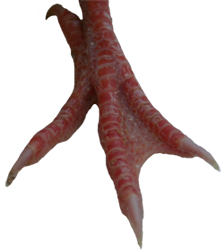
9. X-Pigeons |
||||
wl - web-lethal
 Web-lethal — genetic
symbol wl is
one of the well-known and documented lethal genes found in pigeons.
Webbed toes can be found fairly commonly in pigeons. Usually the
webbing is between the inner
and middle toes, or even all three toes. However, there has been
some variation of the toe-webbing where the webs do not always extend
completely to the claws. It is a sex-linked mutation and therefore
it is near lethal in the homozygous state for cock birds (wl//wl)
and near lethal to hens in the hemizygous state (wl//.). Hens only
have one functional sex chromosome and therefore are referred as
hemizygous. Since hens have no normal counterpart gene on the W chromosome,
a safety backup that compensates, any recessive sex-linked mutation
will present itself on hens. Most of the times the death caused by
web-lethal mutation will happen at hatching. Accrording to Hollander
and Miller study on web-lethal mutation, majority of the abnormal
(web-lethal) squabs either fail to hatch or fail to live over 10
days. Hollander and Miller were able to raise three survivors with
peculiar eyes, where the iris was irregular and pupil looked pear-shaped
or rectangular but vision seemed normal. This study concludes that
even though web-lethal mutation seems to be quite inferior to normal,
and generally lethal (causing death before maturity), perhaps the
survivors have superior residual heredity.
Web-lethal — genetic
symbol wl is
one of the well-known and documented lethal genes found in pigeons.
Webbed toes can be found fairly commonly in pigeons. Usually the
webbing is between the inner
and middle toes, or even all three toes. However, there has been
some variation of the toe-webbing where the webs do not always extend
completely to the claws. It is a sex-linked mutation and therefore
it is near lethal in the homozygous state for cock birds (wl//wl)
and near lethal to hens in the hemizygous state (wl//.). Hens only
have one functional sex chromosome and therefore are referred as
hemizygous. Since hens have no normal counterpart gene on the W chromosome,
a safety backup that compensates, any recessive sex-linked mutation
will present itself on hens. Most of the times the death caused by
web-lethal mutation will happen at hatching. Accrording to Hollander
and Miller study on web-lethal mutation, majority of the abnormal
(web-lethal) squabs either fail to hatch or fail to live over 10
days. Hollander and Miller were able to raise three survivors with
peculiar eyes, where the iris was irregular and pupil looked pear-shaped
or rectangular but vision seemed normal. This study concludes that
even though web-lethal mutation seems to be quite inferior to normal,
and generally lethal (causing death before maturity), perhaps the
survivors have superior residual heredity.
It seems Robert J. Mangile is one of the few people and probably the first person who ever produced and reported raising homozygous web-lethal cock (wl//wl). Until Mangile raised such a bird, it was not thought possible. He raised about 30 offspring from matings with the potential to produce wl//wl cocks. Instead of waiting these offspring to mature, Mangile killed many of them to autopsy them and found that some birds displaying the web-lethal trait (webbed or fused toes) had testes — indicating maleness. According to Mangile, cock birds heterozygous for web-lethal (wl//+) did not display web toes but hemizygous hens (wl//.) and homozygous cocks (wl//wl) did. "Web-lethal hens (wl/.) and web-lethal cocks (wl//wl) both display similar symptoms of morbidity, i.e., affected eyes and pupils, small size, tubular shaped body, toes that vary from almost normal looking to rear & inner toes fused along with outer and middle toes webbed (not fused) - both in varying degrees, some with only one foot showing fused toes and/or webbed toes and some with near normal pupils. The greater the expression of this characteristics the more apt the possessor is to being less vital and/or vigorous," says R. J. Mangile (private communication).
There is a curious case exists in the sex-linked web-lethal mutation. It seems the cock birds carrying a single copy of the web-lethal (wl//+) gene don’t show any signs of abnormal feet or any known health problems. This means that the wild-type gene at the web-lethal locus produces something very important in allowing development of normal feet. We know that hens are hemizygous in their sex-chromosome and don’t have any allelic counterpart. However, although this idea is not fully tested, it seems hemizygous web-lethal hens (wl//.) survive better than homozygous web-lethal cocks (wl//wl) where breeding data shows homozygous cocks die more often as embryos. If this wild-type gene at the web-lethal locus is so essential to survive, why does web-lethal mutation show in the phenotype of hens, but not become as lethal for them? Even though breeding data suggest that homozygous cock birds die more often and only few of them were able to survive, we don’t have any complete statistical analysis of how many of each sex fail to hatch — but we do know that many web-lethals of both sexes die before they hatch. Further research is needed to solve these mysteries of different lethal genes interacting with the wild-type genes and showing various vitality results depending on the presence or absence of other mutations.
References:
1. Hollander,
W. F. and Miller, W. J. (Oct 1982). A New Sex-Linked Mutation, Web-Lethal
from Racing Homers.
American
Racing Pigeon News.
2. Levi, W. M. (1963). The pigeon
(2d ed.). Sumter, S.C.: Levi Pub. Co.
3. Mangile, R. J. Private communication.
4. Quinn, Joe W. (1971). The Pigeon Breder’s
Notebook. QB&Q Publishing.
Copyright May, 2012 by Arif Mümtaz.